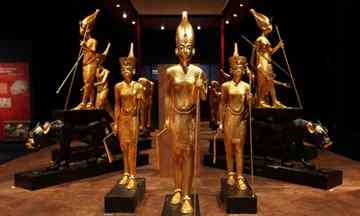"What can you see?" asked the people behind archaeologist Howard Carter as he peered through a newly dug hole into the tomb chamber of the boy king Tutankhamun in 1922. "Wonderful things!" gasped Carter. And it was true.
 Up to then it seemed that all the tombs of the pharaohs of Egypt in the Valley of the Kings had been ransacked by grave robbers long ago: archaeologists found mummies, but no gold. Somehow this young ruler's tomb had never been touched. Carter found its treasures piled around the walls inside the secret chamber, perfectly preserved in the sealed vault, just as they looked the day the tomb was closed. Now you can see them, quite as perfect, in Manchester – with one catch.
Up to then it seemed that all the tombs of the pharaohs of Egypt in the Valley of the Kings had been ransacked by grave robbers long ago: archaeologists found mummies, but no gold. Somehow this young ruler's tomb had never been touched. Carter found its treasures piled around the walls inside the secret chamber, perfectly preserved in the sealed vault, just as they looked the day the tomb was closed. Now you can see them, quite as perfect, in Manchester – with one catch.
The exhibition Tutankhamun – His Tomb and His Treasures, which opened at the Trafford Centre on Friday, boasts the very room that amazed Carter 88 years ago. Golden beds, chairs, chariots, chests and portraits are heaped as they were when he peeked through that tiny aperture: the death mask of Tutankhamun, one of the most astonishing works of art on earth, is here. The only trouble is, none of it is real. All the marvels are reproductions, modelled with digital technology and expertly crafted to mimic the originals, at a cost of £4.4m.
Does it matter? Is this exhibition a con, a delusion, a postmodern joke? Is it not a bit rich to sell tickets to a display that is really no more authentic than a horror film with mummies chasing screaming actors through digitally created pyramids? But to get lofty and highfalutin about it is to forget the history of "Egyptomania", the fascination with ancient Egypt that has long gripped western culture. People have been faking Egyptian artefacts for centuries, and mixing those fakes with real relics, in a way that was not stupid, but rather inspired curiosity, discoveries, learning. In the 17th century, sculptor Gianlorenzo Bernini stuck an ancient obelisk on the back of a stone elephant, mixing real archaeology with his own art. In the age of Napoleon, every fashionable house had a faked-up, Egyptian-style chaise longue. In Regency London you could visit the Egyptian Hall in Piccadilly, a simulated Egyptian temple complete with colossal columns and statues, run as a profitable enterprise (today Harrods has its own Egyptian Hall).
The Manchester event is in this tradition. If it inspires, it inspires. You can visit the British Museum's Book of the Dead show next month to see how real Egyptian relics match up to its illusions. Egyptomania thrives on sensation, and museums and diggers have benefited from the popularity of this most amazing of ancient cultures. Egyptologists learned long ago that fakes are fine, so long as they generate enthusiasm for the real thing.
Author: Jonathan Jones | Source: Guardian [October 24, 2010]